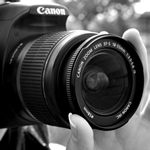
Great photos sell more products! Product photography is crucial to your success when selling products online using your own eCommerce site. Customers expect to find high quality, high resolution images of your products from varying angles and perspectives, highlighting details and features. Images are powerful; we remember what we see more than what we read. Here are my top nine (9) insights — and TWO bonus pro tips — for shooting great product photography.
Taking Product Photos
The easiest solution for getting product photography is to hire a product photographer — someone that has a background in shooting images of products, preparing the background, ensuring that a minimal amount of deadspace is in the photos and perfecting the lighting. Professional photographers will even spend time in Lightroom or Photoshop after they’ve taken the photos to ensure that the colors and light is balanced properly. These are all very important tasks when shooting product photos, but this comes at a price. A good product photographer will likely cost thousands of dollars.
If you are not ready to put that kind of money into a pro, then consider shooting the images yourself. But do not assume that this will be a fast and easy task. Prepare thoroughly, and you can do it! Here are my do-it-yourself (DIY) tips for success:
1. Think through the photo shoot before you get started
Before getting started with the photos, take the time to write down all the things that need to be done beforehand. Think through the equipment you will need, when you will shoot, who will help you, what products will be shot, etc. Think about the details of your products and what features you need to highlight. Getting these plans down on paper is a great way to organize yourself and ensure you will get every shot you need. Every pro does this before a shoot.
2. Set up a product photography studio
You need to take your “studio” seriously. Set up a small area of your office or warehouse for the shoot. This is a space where you can hang a backdrop, set up lights and a tripod, and leave everything as-is for the entire duration of the shoot. I’ve been to offices where a photo studio remains at all times, because the team understands the importance of product photography.
3. Use a lighting kit
The secret to great photographs is perfect lighting. Just as audio can make or break a video production, lighting is the must-have for your photography. If you can get your light right, then your shots will be outstanding. The trouble is, natural light is uncontrollable, and simply relying on overhead fluorescent lights has so many faults. To get great shots, you must rely on lighting kits. Lighting kits do not have to be excessively expensive, and they will make a major difference in your final shots. A three light kit is likely all you will need. If you are only doing product photos, then a strobe kit is best. However, if you also plan to use your lighting kit for videography (interviews, product action shots, etc.), then you’ll need a continuous lighting kit (one where the lights remain on and don’t flash). You'll want to learn more about various kits, their features and strategies. One thing to remember, though, is that lighting is not nearly as complicated as some like to make it. Just surrounding your product with lights while shooting will improve your shots dramatically.
Pro Tip — If you are on a super tight budget, build a DIY lighting kit using LED construction lights from a honme improvement store such as Home Depot or Lowe's. Lighting kits these days are really affordable already, but using construction lights may shave off another 25%.
4. Use Lightbox
If you are shooting small products, consider using a Lightbox. You can make your own by creating a small "box" made of white cloth in which you can place your product and add light from the outside. The cloth walls will disperse your light over the product in a soft and equal manner and will give your product the illusion of “floating in white space."
5. Be aware of your backdrop
Once you have your product set up and surrounded by lights, you want to be conscious of what is in the background of your shots. If you can, hang a solid color backdrop behind the product. This could be a professional backdrop, or it could be a king-sized sheet in your preferred color. In some cases, including an active backdrop is useful. For instance, if you are shooting a piece of construction equipment or a construction tool and you can include a backdrop of a blurred out construction site, that would be very useful in setting the proper environment or setting for your product's use. Having a backdrop of your office, conversely, would not.
6. Use a professional camera
Once you have your studio set up, the lighting is perfect, you have an appropriate backdrop and your products are ready, it’s time to start shooting. At this point, you may plan to just pull out your camera phone and start taking a pics. Come on! Really!?
Yes, camera phones are quite impressive these days, and one could make an argument that it’s all you need, but you don’t have any control over your camera phone. Meaning, all of your pictures are taken automatically. The biggest downside of camera phones, though, is the lens.
If you have a lot of products, and you will likely continue shooting products into the future, consider purchasing a digital single-lens reflex (DSLR) camera. You don’t have to buy a top of the line camera for these shots. A lesser expensive Canon or Nikon DSLR that you pick up from a big box store such as BJ’s or Costco would do the trick. What you get from DSLR that a camera phone can’t supply is the quality lens, the control over shutter speed and aperture, and the control of the ISO*. Not to mention that you need a good camera to trigger a lighting strobe kit. While those features may mean nothing to you, it's ok. With today’s DSLR cameras, you can shoot on “Auto” and still have control over some elements of the shot. For instance, using the camera's settings you can tell it, “No matter what, ensure that my shots are taken at at least 1/200th shutter speed." This will ensure your shots are crisp, and the camera will do all the work of adjusting the ISO and aperture to meet that requirement.
*ISO stands for International Standards Organization, and in photographic terms, it's an industry standardized measuring scale for sensitivity to light as it pertains to the a digital image sensor.
Pro Tip — It’s worth the $20 to buy a remote for your camera. With a remote, you don’t even need to touch your camera. Once your camera is on the tripod, you simply set your product down, step out of the way, click the button on your remote and the shot is taken. Then onto the next product.
7. Use a tripod
The tripod is such an important tool to have for product photography. Using a tripod will accelerate your product shooting process time by at least tenfold, and it will ensure that all your product shots are consistent in lighting and scale. Imagine a scenario where you have your studio set up, you have your camera on a remote, the lighting has been perfected, and you are ready to begin shooting your products. In this case, you simply sit your product down and take a shot. Change the angle of the product and take a shot. Place the next product and take a shot. Now you are manufacturing product photos! This is how you shoot 100 products in one day. Everything is “perfected,” and you just need to collect the images.
8. Check the initial shots on your computer
Once you are all set up, and you are ready to begin shooting, take a dozen shots then review them on your computer. There is nothing worse than spending eight (8) hours shooting photos just to find that final images aren’t exactly what you wanted. Once you have your studio set up, and the lighting is just right, you should be able to trust that the environment will be constant for the rest of the day. Taking those first few shots, then verifying that they are “perfect” will give you confidence that the other 90 products you shoot that day will turn out just as good.
9. Upload and manage product photography on your eCommerce site
Here's a tutorial on how I upload and manage product photography on my eCommerce site.
For a few examples of really great product photos, see below and visit Chris King Precision Components, a performance bicycle component manufacturer based in Portland, Oregon. If I wasn't already a bike nut, their photos would turn me into a disciple!

Conclusion
Taking high quality product photos is a science and an art, especially when you are shooting in-studio images without props and actors. Anyone can learn to do this, and with the right equipment and an organized to-do list, it can be a straight-forward, “manufacturing” like process.
Just remember that digital shots are cheap. Take as many shots as you can and at as many angles as possible. There is nothing lost — yet everything to gain — by taking 10 more pictures than you end up using. Experimentation leads to great shots.
Good luck, and have fun!
